Pallet Inverter: Can You Automate Pallet Rotations in Busy Fulfillment Centers?
As an engineer and founder of a packing machine factory, I've walked through hundreds of facilities. I see the same pressure everywhere. Operations managers in busy fulfillment centers and large-scale manufacturing plants, like steel mills, are constantly battling bottlenecks. One of the most common, yet overlooked, is pallet handling. Manually transferring goods from one pallet to another is slow, dangerous, and a drain on your resources. It creates logjams that ripple back through your entire production line, putting your efficiency targets and delivery schedules at risk. What if you could eliminate this manual bottleneck completely, making the process faster, safer, and perfectly consistent every single time?
Yes, you can absolutely automate pallet rotations in busy fulfillment centers and industrial warehouses using a pallet inverter. This specialized machine is engineered to securely clamp and rotate a full pallet load, allowing for the quick and safe exchange of pallets. It transforms a labor-intensive, high-risk manual task into a streamlined, automated process that takes less than a minute.
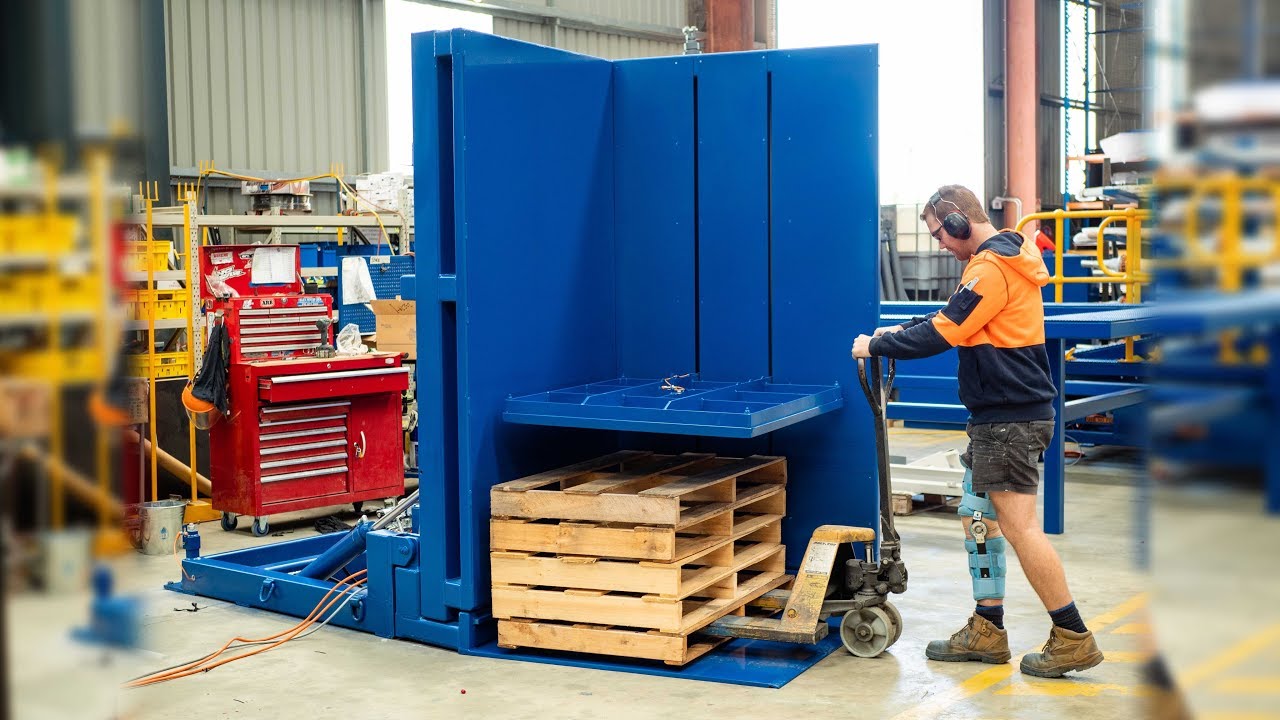
I understand the hesitation. As a business owner, you need to justify every equipment purchase with a solid return on investment. You're not just buying a machine; you're investing in a solution that must solve a real problem and contribute to your strategic goals, whether that's increasing throughput, improving safety, or cutting operational costs. So, let's move beyond the simple "yes" and explore the practical impact a pallet inverter can have on your operations. We will look at how it directly addresses the challenges faced by leaders who are responsible for productivity and profitability.
How Does a Pallet Inverter Increase Operational Efficiency?
Does your team spend valuable time manually unstacking and restacking goods just to switch out a broken or unsuitable pallet? This process is a classic example of non-value-added work. It consumes labor hours and creates a major speed bump in your logistics flow. Every minute your skilled workers spend on this repetitive task is a minute they are not focused on more critical, value-generating activities. This inefficiency directly impacts your throughput and can make goals, like achieving 95% equipment uptime, feel out of reach. There is a much better way to handle this common problem.
A pallet inverter dramatically increases operational efficiency by replacing a slow, multi-step manual process with a single, rapid automated action. It can perform a complete pallet exchange in about 60 seconds, a task that could take two workers 15 to 20 minutes to do by hand. This allows you to reallocate your workforce to areas like quality control, packing, or shipping, where their skills can create more value.
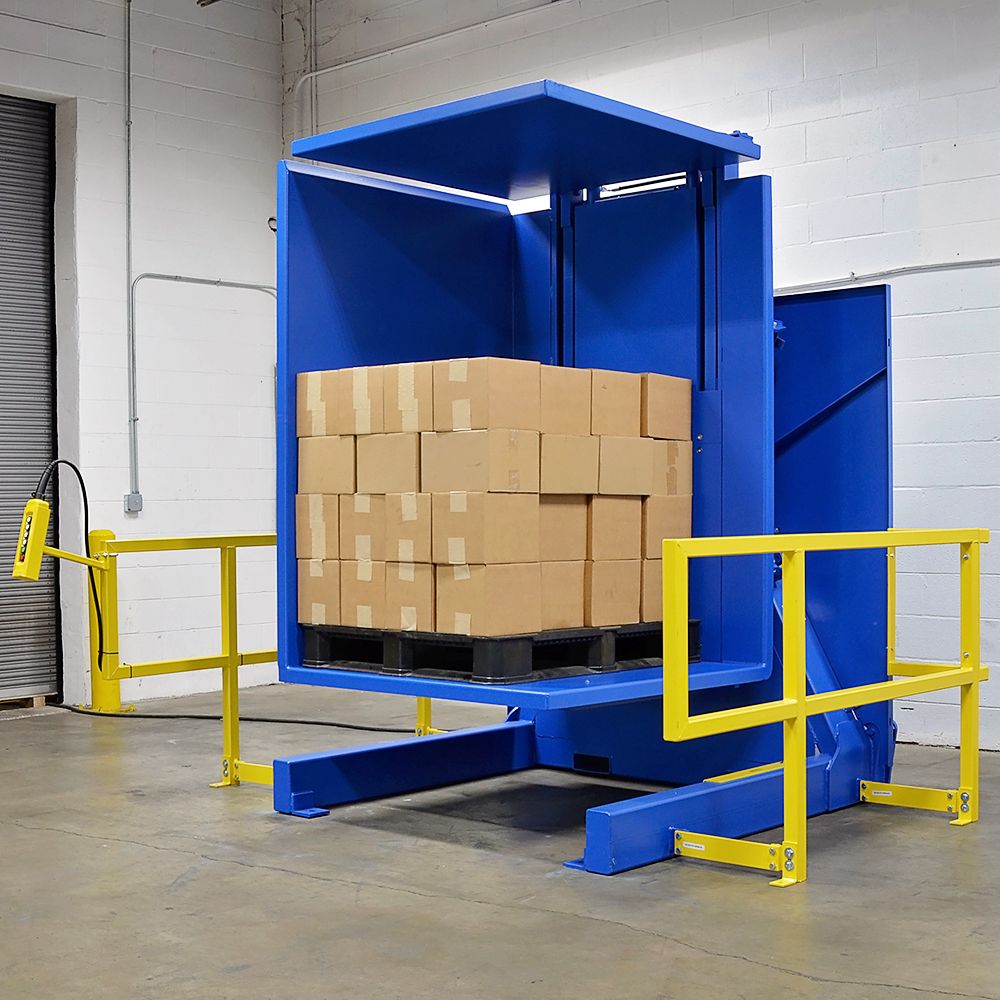
Dive Deeper: A Quantitative Look at Efficiency Gains
When I talk with plant owners like Javier Morales, the conversation always turns to numbers. A pragmatic leader needs to see a clear path from investment to return. The efficiency gains from a pallet inverter are not just theoretical; they are tangible and measurable. Let's break down the impact.
The most immediate benefit is speed. Consider a scenario where you need to switch 50 pallets per day.
| Metric | Manual Pallet Exchange | Automated Pallet Inverter |
|---|---|---|
| Time per Pallet | 15 minutes | 1 minute |
| Labor Required | 2 workers | 1 operator (part-time) |
| Total Time (50 pallets) | 12.5 hours (2 workers) | 50 minutes (1 operator) |
| Total Labor Hours | 25 labor-hours | ~1 labor-hour |
The numbers speak for themselves. You reclaim over 24 labor-hours every single day. This is not about eliminating jobs. It's about elevating them. Your team members are your most valuable asset. Freeing them from the strenuous, repetitive task of manual handling allows you to deploy them to more strategic roles. They can oversee the automated line, perform quality assurance checks, or manage inventory—tasks that require human intelligence and contribute directly to your bottom line.
Beyond Speed: System-Wide Impact
The efficiency boost extends beyond just one task. A pallet inverter removes a critical bottleneck. In a steel mill, for example, finished coils or stacked products need to be moved from in-house "production" pallets to stronger, standardized "shipping" pallets. If this process is slow, it creates a backlog. The entire packaging and shipping department grinds to a halt, which can eventually stop the production line itself. By automating the pallet exchange, you ensure a smooth, continuous flow from production to dispatch. This helps increase your overall plant capacity utilization. It also improves predictability in your logistics chain, making it easier to meet delivery deadlines and keep your customers satisfied. This is a key step in achieving the kind of operational stability that every successful enterprise is built on.
What are the Safety and Product Protection Benefits?
Manual pallet handling is one of the leading causes of workplace injuries, particularly musculoskeletal disorders like back strains. When your team has to lift and move heavy items repeatedly, the risk is high. At the same time, this manual process puts your products in jeopardy. A single slip or unstable stack can lead to dropped goods, resulting in costly damage and waste. For a business leader, an accident means more than just a report. It means potential lost work time, increased insurance premiums, and a negative impact on team morale. Protecting your people and your products is not just a regulatory requirement; it is a fundamental part of running a profitable and sustainable business.
A pallet inverter offers a powerful solution by engineering these risks out of the process. It creates a secure, controlled system that protects both employees and products. The machine firmly clamps the entire load before gently rotating it, eliminating the need for any manual lifting or restacking. This drastically reduces the physical strain on your workers and keeps your valuable goods safe from handling-related damage.
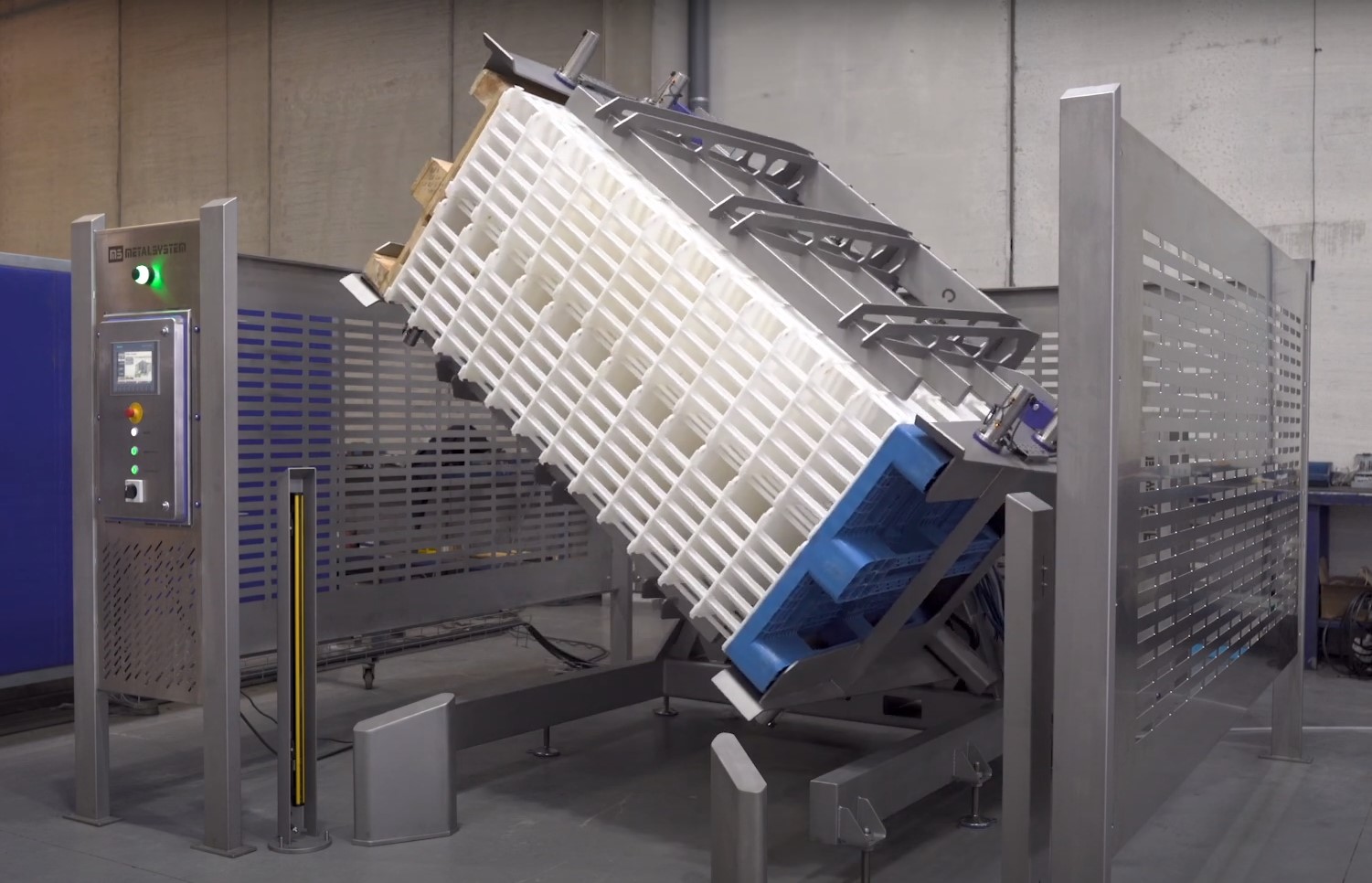
Dive Deeper: Building a Culture of Safety and Quality
A commitment to safety is a hallmark of a well-run operation. From my experience as an engineer, I know that the best way to improve safety is to design out the hazard. A pallet inverter does exactly that.
Eliminating Ergonomic Risks
The primary safety benefit is the near-total elimination of manual material handling during pallet transfers. The physical demands of this task are significant. Lifting boxes, bags, or components, often in awkward positions, is a recipe for injury.
| Risk Factor | Manual Handling | With Pallet Inverter |
|---|---|---|
| Risk of Back Injury | High | Negligible |
| Risk of Repetitive Strain | High | Negligible |
| Risk of Dropped Objects | Moderate to High | Very Low |
| Worker Fatigue | High | Low |
By automating this, you are not just preventing injuries; you are creating a better working environment. It shows your team that you value their well-being. This can lead to higher morale, lower employee turnover, and a stronger safety culture across your entire facility. For a leader like Javier, who has risen through the ranks from a team leader, this is not an abstract concept. He knows firsthand the physical toll of factory work and the importance of looking after his people.
Guaranteeing Product Integrity
In addition to worker safety, the pallet inverter is a guardian of your product quality. In a steel plant, for instance, coils of wire or stacks of precisely cut metal sheets are high-value items. Damage during in-plant handling is a direct loss of profit. Manual restacking introduces many variables: an uneven stack, a moment of inattention, a sudden shift. A pallet inverter removes this uncertainty. Its adjustable clamping system applies consistent, even pressure, securing the load without crushing it. The rotation is smooth and controlled. This ensures that your products arrive at the next stage of production or at the customer's door in perfect condition. This directly supports the goal of maintaining high-quality standards and protecting your hard-earned profit margins.
Can a Pallet Inverter Fit into My Existing Workflow and Digital Strategy?
You are actively pushing your company towards a smarter, more connected future. You are investing in MES (Manufacturing Execution Systems), IoT sensors, and data analytics to gain full visibility over your operations. The last thing you want is to purchase a new piece of equipment that operates in isolation, a "dumb" machine that cannot communicate with your intelligent factory ecosystem. This creates a data black hole and can even disrupt the automated workflows you are trying to build. Will a pallet inverter become another isolated island of automation, or can it be a true participant in your digital transformation strategy?
Yes, modern pallet inverters are designed with integration in mind. They are not the standalone, manually operated machines of the past. Today's inverters can be supplied with advanced PLC controls and communication interfaces that allow them to connect seamlessly with your existing conveyor systems and plant-wide management software like an MES or WMS. This allows them to become a fully integrated, data-generating node in your smart factory.
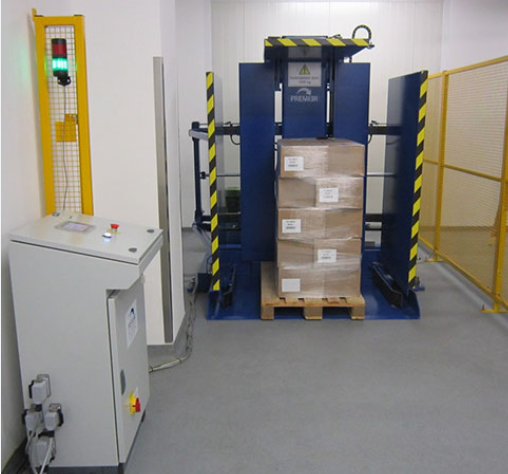
Dive Deeper: From Mechanical Asset to Data-Driven Partner
For a forward-thinking leader like Javier, who is championing a digital transformation, a machine's ability to integrate is just as important as its mechanical function. The goal is total production visualization, and every piece of equipment must contribute.
Seamless Physical and Digital Integration
A pallet inverter can be implemented in two primary ways. It can be a standalone station where a forklift operator loads and unloads pallets. This is a great starting point for many facilities. However, for a fully automated workflow, it can be integrated directly into a conveyor line. Pallets automatically enter the inverter, are exchanged, and then exit onto another conveyor without any human intervention. This is where the true power of automation is unlocked.
But the integration goes deeper. The machine's control system (PLC) can be programmed to speak the same language as your central factory systems.
| Pallet Inverter Feature | Contribution to Digital Strategy |
|---|---|
| Cycle Count Sensor | Provides real-time throughput data to MES for OEE calculation. |
| Fault/Status Outputs | Sends alerts to the control room for immediate action. |
| Motor Current Sensors | Feeds data to a predictive maintenance platform to anticipate failures. |
| PLC Communication | Enables two-way communication with the MES for automatic recipe selection. |
Supporting Predictive Maintenance and Intelligent Operations
Javier's goal of increasing equipment uptime to 95% relies heavily on moving from reactive to predictive maintenance. A smart, connected pallet inverter is a key enabler of this strategy. By monitoring data points like motor amperage, hydraulic pressure, and cycle times, your system can learn the machine's normal operating baseline. When deviations occur, the system can flag a potential issue long before it leads to a breakdown. This allows your maintenance team to schedule repairs during planned downtime, avoiding costly emergency stops.
I remember working with a client who was building a new, highly automated warehouse. They were concerned about this exact issue. We worked with their engineers to ensure our pallet inverter's PLC could communicate directly with their WMS. Now, when a pallet of a specific product arrives, the WMS tells the inverter the correct clamping pressure to use, preventing any chance of operator error. The inverter, in turn, reports back every cycle completion and its own health status. It's a true strategic partnership between machines, which is the foundation of Industry 4.0.
My Insights: What are the Hidden Costs and ROI Considerations Beyond the Sticker Price?
When you look at a proposal for a piece of equipment like a pallet inverter, your eyes naturally go to the purchase price. As a business owner who has to make these decisions, I understand that this is a significant capital investment. You run a strict feasibility analysis for every major purchase, and you need to be certain about the return. However, focusing only on the initial cost is a common mistake that can be very misleading. A cheaper machine might end up costing you far more in the long run through frequent breakdowns, higher maintenance needs, and unexpected downtime.
From my own journey, starting as an engineer and building my own factory, I have learned that the true value of an investment is found by looking at the Total Cost of Ownership (TCO) and the strategic benefits it unlocks. The real question is not "What does it cost?" but "What does it save and what does it enable?" A reliable machine from a supportive partner is one of the best investments you can make.
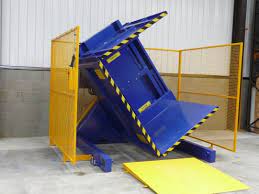
Dive Deeper: A Framework for True ROI Analysis
A leader like Javier needs a comprehensive framework to evaluate this kind of investment. It's about moving from a simple expense mindset to a strategic investment mindset. Let's build that framework.
Calculating the Total Cost of Ownership (TCO)
The initial price is just the beginning. A thorough analysis includes:
- Purchase & Installation: The price of the machine plus the cost of shipping, commissioning, and integrating it into your facility.
- Training: The cost of training your operators and maintenance staff to use and care for the new equipment properly.
- Energy Consumption: This is a key challenge for Javier. You need to know the machine's power requirements and factor that into your operational cost models. Modern machines are often more energy-efficient than older ones.
- Maintenance & Spares: What is the recommended maintenance schedule? What is the cost and availability of spare parts? A reliable machine from a partner with strong after-sales support will have a much lower TCO here. This is where choosing a cheap, unsupported machine can become incredibly expensive.
Quantifying the Return on Investment (ROI)
Once you understand the costs, you can quantify the savings and gains. This is the other side of the ROI equation.
| ROI Category | How to Quantify It |
|---|---|
| Reduced Labor Costs | (Hourly wage + benefits) x (Labor-hours saved per day) x (Operating days per year) |
| Eliminated Product Damage | (Average value of damaged goods per incident) x (Reduction in incident frequency) |
| Increased Throughput | (Value of additional units produced/shipped per hour) x (Hours gained) |
| Reduced Injury Costs | (Average cost of a workplace injury) x (Reduction in risk likelihood) |
| Lower Employee Turnover | (Cost to hire/train new employee) x (Improvement in retention rate) |
I once worked with a client who ran a large distribution center. He was very hesitant about the initial cost. We sat down together, just like this, and built a simple spreadsheet with these exact categories. We used his actual numbers for wages, product value, and throughput. The calculation showed a payback period of just 18 months. He called me two years later to say the machine had paid for itself in 14 months and that the biggest benefit—one he hadn't even factored in—was the reduction in stress for his warehouse supervisor. That's the kind of ROI that doesn't always show up on a spreadsheet but is incredibly valuable.
This is why I believe in being more than a supplier. We must be a strategic partner who helps you think through these challenges and find the right total solution.
Conclusion
A pallet inverter is more than a machine; it's a strategic tool. It automates rotations to boost efficiency, enhance safety, and deliver a strong, measurable return on your investment.


